Boy, is it a good time to be a woman?! When equal gender rights and diversity initiatives gain momentum. When top health apps target women. When special venture funds invest solely in femtech. When the New York Times publishes articles like this — clearly something’s in the air.
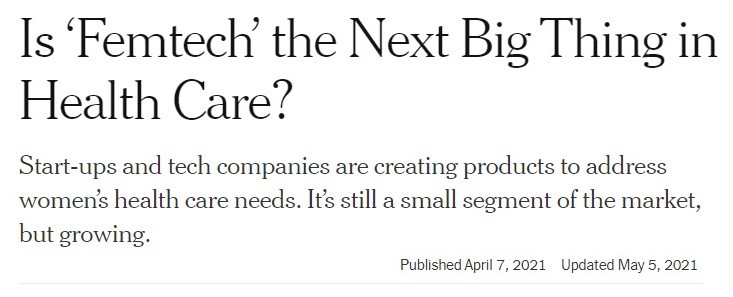
So without further ado, let’s discuss how to develop a women’s health tracking mobile app.
A quick note to our she-readers: please, bear with me because I’m not a woman and may miss some nuances. Yet, I admire femtech and genuinely want to help you create a women’s health tracker application that can top the mobile charts.
And here’s a little secret – our team isn’t just packed with tech wizards; it’s also home to fantastic product managers, designers, QA specialists, and more, who happen to be women. They’re not just building these modern femtech solutions; they’re using them too! So, they bring their firsthand user experience to the table, ensuring we develop apps that are not just functional, but truly resonate with women.
Top Takeaways
- The women’s healthcare market has a real potential to explode in the coming years, reaching $50b globally by 2025.
- Some of the biggest trends driving women’s health tracking app development include the internet of things, artificial intelligence, and remote patient monitoring.
- When you develop women’s health applications, keep in mind integrations with HealthKit/Google Fit, implement granular control over notifications, and focus on creating discreet user experiences.
Table of Contents
1. Women’s Health App Market
2. The Best Examples of Apps for Women’s Health
3. How to Create Women’s Health Tracking App in 5 Steps
- Step 1: Create a Prototype
- Step 2: Start Coding the App
- Step 3: Add Security Mechanisms
- Step 4: Test and Fix Bugs
- Step 5: Release and Maintain
4. Best Practices and Challenges of Starting a Women’s Health Tracking App
5. How Can Topflight Apps Expertise Help You Develop Apps for Women’s Health?
Women’s Health App Market
I believe we’re at the very beginning of explosive growth of the femtech market. Research suggests that the women’s health market will reach $50 billion by 2025. Look at how the funding of female health tracking apps has grown recently.
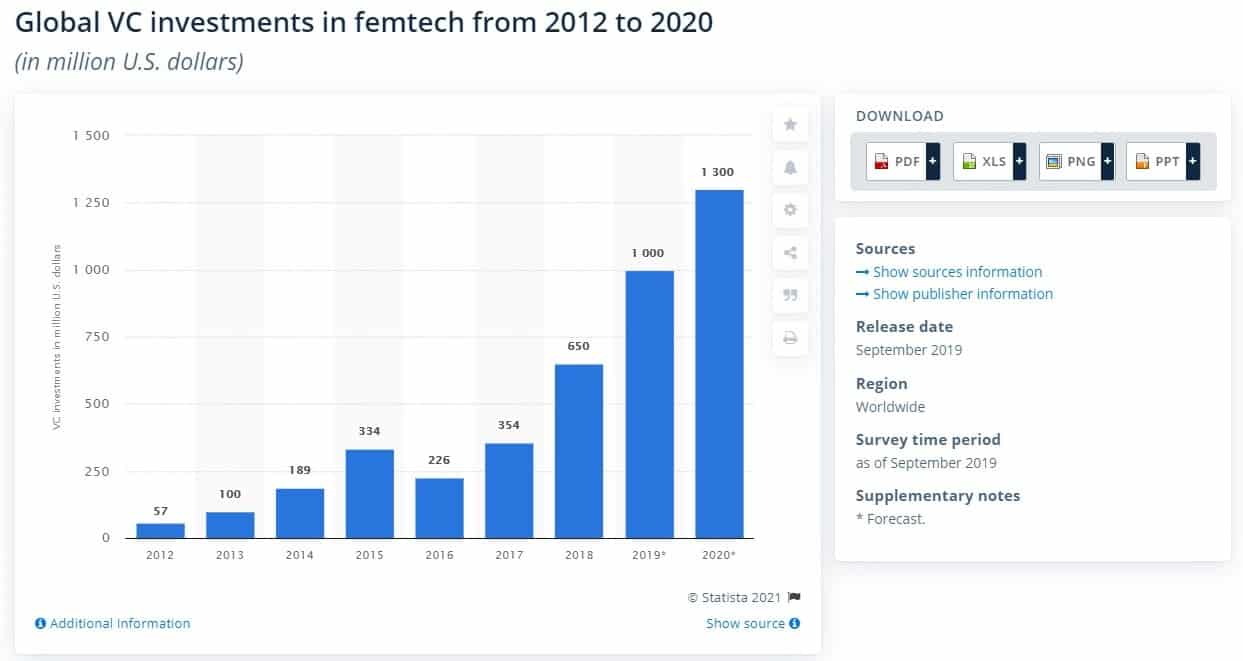
In fact, the signs are all over the place. I really started paying attention only after hearing that Apple updated its fitness software with workouts for pregnancy in April 2021. This company never ventures into anything unless there’s a high chance of getting high returns.
What other signals urge us to consider pregnancy tracking mobile app development or other women’s health solutions?
- FDA cleared Clue’s cycle tracking application for birth control in February 2021
- Female-focused investment VCs, e.g., Portfolia, Fermata, and Avestria Ventures, funding women’s health startups exclusively
- Women make 80% of health care decisions in the U.S.
- Only 3% of digital-health funding in 2020 backed femtech startups
- Femtech startup accelerators springing to life
- M&A activity in 2021: for example, Halma acquired fetal surveillance system PeriGen, and Ro bought Modern Fertility to expand into reproductive health services.
There are only 200 or so femtech startups globally at this time (compared to 1200 in fintech, for example), and many of these companies innovate by applying IoT, AI/ML, and telemedicine technologies.
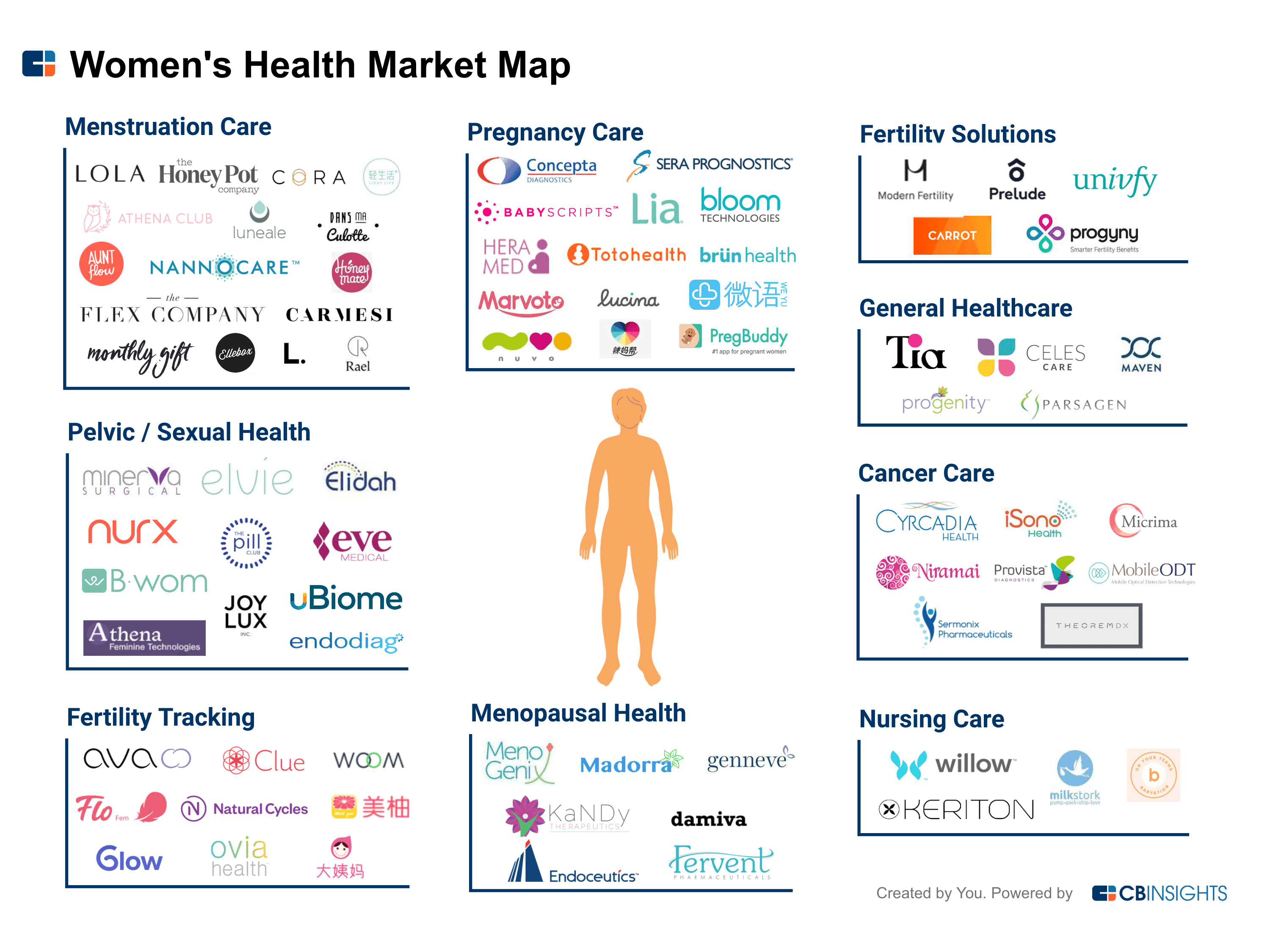 I expect new entrants to continue focusing on these technologies to address women’s health issues in such untapped areas as menopause, fibroids, geriatric care, endometriosis, mental health, and personalized holistic care.
I expect new entrants to continue focusing on these technologies to address women’s health issues in such untapped areas as menopause, fibroids, geriatric care, endometriosis, mental health, and personalized holistic care.
Also read about diet and nutrition app development.
The Best Examples of Apps for Women’s Health
To someone not familiar with the burgeoning femtech space, women’s health applications must look like a playground for competing menstrual cycle tracking apps. However, the reality is there are all sorts of women’s health apps out there.
There are sexual health and birth control applications, perimenopause and menopause symptom tracking solutions, maternity and children’s health apps, mood and wellness tracking software, telemedicine applications, and a multitude of smart appliance controlling products.
Let’s take a look at some of the most popular mobile products and where healthcare app development comes into play.
The best app to track periods, fertility, and pregnancy
![]()
Flo is an established cycle tracking mobile solution that combines other aspects of women’s health into its feature set like many other applications. The product helps users to accurately monitor cycles, fertility, or pregnancy. Women can even follow their babys’ growth weekly during pregnancy.
Founded: 2016
Capital raised: $25.5m
Headquarters: San Francisco, California
Competition: Clue, Glow, Ovuline
For more tips on how to develop a fitness app, check out our dedicated guide.
Top Internet-of-Things women’s health app
Bloomlife innovates maternal health, an area with astonishingly high maternal mortality and morbidity rates. The company offers a combination of a smart sensor, able to track contractions, and a mobile application that interprets the data through intuitive charts.
![]()
In essence, Bloomlife is the best blend of IoT and remote patient monitoring technologies, which we believe will revolutionize the entire industry.
Founded: 2014
Capital raised: $14.4m
Headquarters: San Francisco Bay Area, California
Competition: NFANT Labs, Bellabeat, ExtantFuture
High-ranking virtual clinic software for women
Ovia Health is a digital platform supporting the entire family care continuum: from women’s health to maternity to parental well-being to children’s health. As you’d expect, patients get to interact with the company’s services through a mobile solution. The software supports clinical programs, remote health monitoring, telemedicine, and on-demand services.
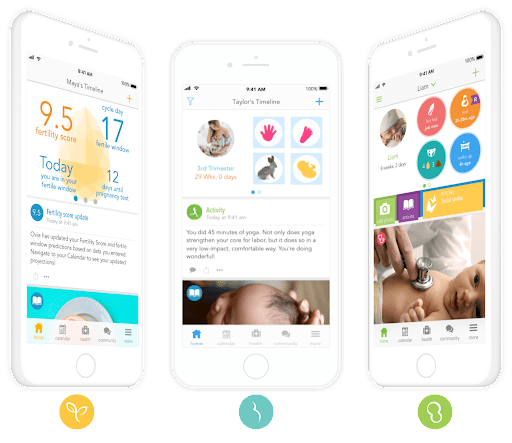
Founded: 2012
Capital raised: $23.3m
Headquarters: Boston, Massachusetts
Competition: Tia, Genneve, Maven
How to Create Women’s Health Tracking App in 5 Steps
The challenge with describing how to build a women’s health tracking app is the versatility of all these solutions. As you probably noticed from the previous section, there are plenty of femtech applications out there, catering to various women’s health needs and, therefore, having different feature sets.
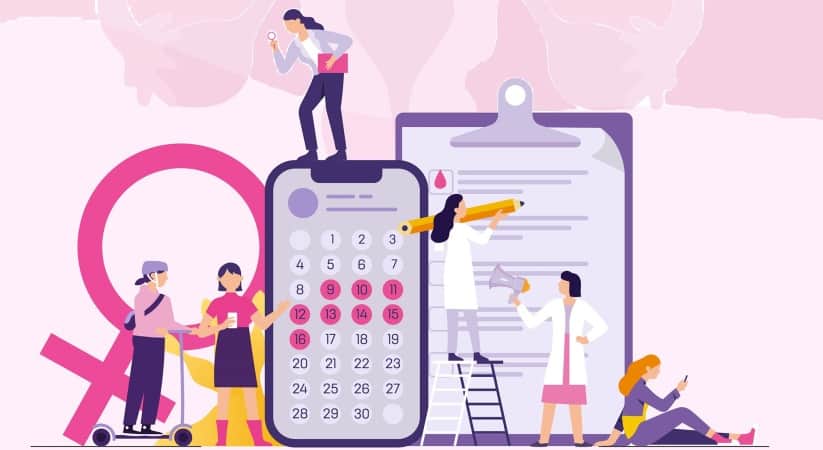
So instead of discussing how to create a period tracking app or some other specific femtech software, let’s review all critical aspects of developing your own women’s health tracking app in general.
Developing a women’s health tracking app requires specialized expertise in custom mobile application development to meet user needs effectively.
Here’s a brief overview of the process, step by step:
| Step | Key Actions | Pro Tips |
|---|---|---|
| 1. Prototype Development | – Create low-fidelity wireframes for quick iterations. – Develop high-fidelity prototypes with polished designs. – Validate the prototype with real users using tools like Usertesting.com. | – Focus on user testing early to refine UX. – Modify prototypes to save on development costs later. |
| 2. Coding the App | – Decide between native (Swift/Kotlin) or cross-platform frameworks (React Native/Flutter). – Integrate with HealthKit, Google Fit, or third-party tools for telemedicine, chat, and notifications. – Add AI/ML for personalization or IoT for device connectivity. | – Use off-the-shelf SDKs for faster development. – Prioritize cloud-based AI for cross-platform compatibility. |
| 3. Build Security Mechanisms | – Comply with HIPAA, GDPR, and ISO27001. – Encrypt data in transit and at rest. – Use secure login options like FaceID or TouchID. | – Ensure users can easily delete their accounts and associated data. – Avoid storing personal health data in cloud services like iCloud. |
| 4. Testing and Debugging | – Perform automated tests with tools like Crashlytics and Sentry. – Conduct manual testing in real-life situations to refine UX. – Test on a wide range of devices and OS versions. | – Focus on usability for common scenarios like one-handed use. – Visualize real-life user behavior to preempt UX issues. |
| 5. Release and Maintenance | – Allocate time for App Store and Google Play submission. – Monitor app performance with tools like Google Analytics. – Plan updates for new OS versions and user-requested features. | – Use TestFlight for a limited release to gather final feedback. – Pay attention to privacy policy and PHI handling to avoid app rejections. |
Step #1: Develop a women’s health tracking mobile app prototype
When you build a women’s health tracking app from scratch, the first step is to create a prototype. This includes creating a low-fidelity and high-fidelity prototype.
The low-fidelity version consists of wireframes and allows you to quickly iterate, apply different visual architectures, and find the right fit for the user experience.
The high-fidelity prototype comes to life when you apply a polished graphical design on top of the low-fidelity mockup. At this point, you need to validate the prototype with real users. We recommend using such tools as usertesting.com for this purpose.
User testing helps you uncover hiccups in the UX and determine if the design appeals to your target audience. Fortunately, it’s relatively easy and, therefore, inexpensive to modify a prototype than tinker with code. That’s the #1 reason why you should start women’s health tracking app development in this fashion.
Related: User Testing: A Comprehensive Guide
Step #2: Start coding the app
Coding is the least fun part of the process for many business owners when they make a women’s health tracking app. However, that’s likely to change as soon as you start receiving early versions of the mobile product. By all means, seek to provide as much feedback on every shipped build as possible because that will directly affect how your prototype converts in a real-life application.
Native or cross-platform?
One of the first things to consider when starting development is to decide whether to use or pass on mobile cross-platform frameworks like React Native or Flutter. Of course, the alternative is to go fully native, using Swift for iPhone and Kotlin or Java for Android.
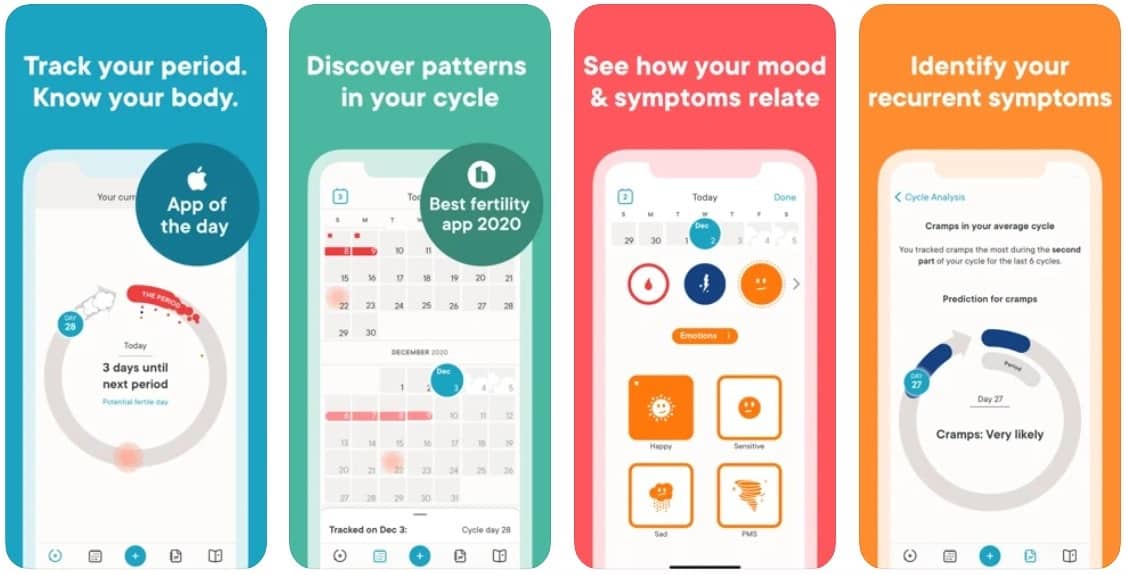
After reviewing popular women’s health mobile software (think Flo, Clue, Natural Cycles, and similar), I can confirm that most of these apps can be built using React Native, Flutter, or other mobile development frameworks. As a result, you will ship iOS and Android versions faster while spending a more tangible budget.
The native approach is a must only for graphics-intensive applications with many custom animations, 3D models, and game-like user experiences. Undoubtedly, natively built apps will perform better in that scenario.
Related: Choosing between React Native and Cross Platform: The Best Choice for You
Integrate with HealthKit and Google Fit?
Another important aspect of crafting engaging experiences in mobile femtech solutions is integration with HealthKit on iOS and Google Fit on Android. These tools function as sort of health hubs, collecting and sharing health data among other installed applications and connected wearables.
With iOS, you can also integrate with ResearchKit if your app aims to scale a health study or with CareKit if you want to bring on Ob/Gyn specialists. CareKit integration allows users to:
- follow treatment plans while care providers track their progress
- review charts with insights based on gathered health data
- quickly connect with their doctor

Use third-party integrations?
If you know Topflight a little, we are huge proponents of using proper off-the-shelf solutions to quickly add different features to your mobile application. Why reinvent the wheel and build a feature from scratch if it already exists and can be easily tweaked to fit your use cases?
Here are some tools worth integrating into your mobile product.
- HIPAA compliant telemedicine engines for audio/video calling (e.g., Agora.io)
- real-time chatting (e.g., Twilio)
- robust notifications (e.g., PushWoosh)
- nutrition databases (e.g., CalorieKing)
- analytics platforms for measuring user engagement (e.g., Mixpanel)
In fact, there’s a high chance you’ll find a proper off-the-shelf solution for virtually any feature in your application. The idea is to quickly assess whether a tool provides all required options and whether it can be easily customized to your needs.
Add AI/ML?
As noted above, AI and IoT are two significant trends in femtech right now. So it behooves any app owner to gracefully add these features to their software.
We have rather insightful separate blogs covering AI/ML app development and IoT app development, where you can spot some best practices.
![]()
Admittedly, IoT and ML will only find their way into your solution if they align with its purpose and help customers achieve their goals faster.
One thing I want to mention about implementing machine learning functionality is if you choose to host it right in the application (rather than in the cloud), ensure that you develop a women’s health tracking application using native technologies. The upside will be smooth performance and privacy, as health data will remain on the phone.
As for IoT connectivity, you’re still fine using Flutter or similar technologies because there are plenty of open-source libraries for working with BLE (Bluetooth Low Energy) to exchange data between the mobile solution and smart devices.
Related:
- A Guide to Developing a BLE App
- IoT App Development: The What, Why, and How
- How to Build a Winning ML App
- A Guide to GLP-1 Virtual Clinics
Remember about the back end
Let’s also remember that even if we only plan to build an ovulation tracking app, which may seem rather simplistic, we still need to develop a web app. This admin web portal will help us manage our mhealth app’s content.
Building the back end is also important because it typically hosts user data and shares it between applications. For example, you may want to create a website to allow your customers to view their data on larger screens.
Step #3: Build in security mechanisms
When you start to make a women’s health tracking application, you’ll discover that the app will deal with protected health information (PHI) a lot. Therefore, security is absolutely not something to scoff at.
You need to protect users’ health data on all possible levels:
- comply with the HIPAA regulations
The bare minimum here is to encrypt all data in transit and at rest and use a secure protocol (HTTPS) to exchange data between a server and the mobile solution.
- use secure login options
Two-factor authentication would probably be overkill for a femtech app, but FaceID or TouchID ideally serve this purpose.
- comply with the GDPR guidelines if you target the European market too
Remember the rule to be forgotten, which means the user must have an easily accessible option to remove their account with all data from your product.
- comply with ISO27001, SOC2 Type 2, and IEC 62304
These are security standards that medical IoT software needs to comply with.
Step #4: Test and fix bugs
It may sound too obvious, but women’s health apps should be tested by women, ideally in the context of real-life situations:
- Can the user easily work with charts using one hand?
- How long does it take for the data to load/process?
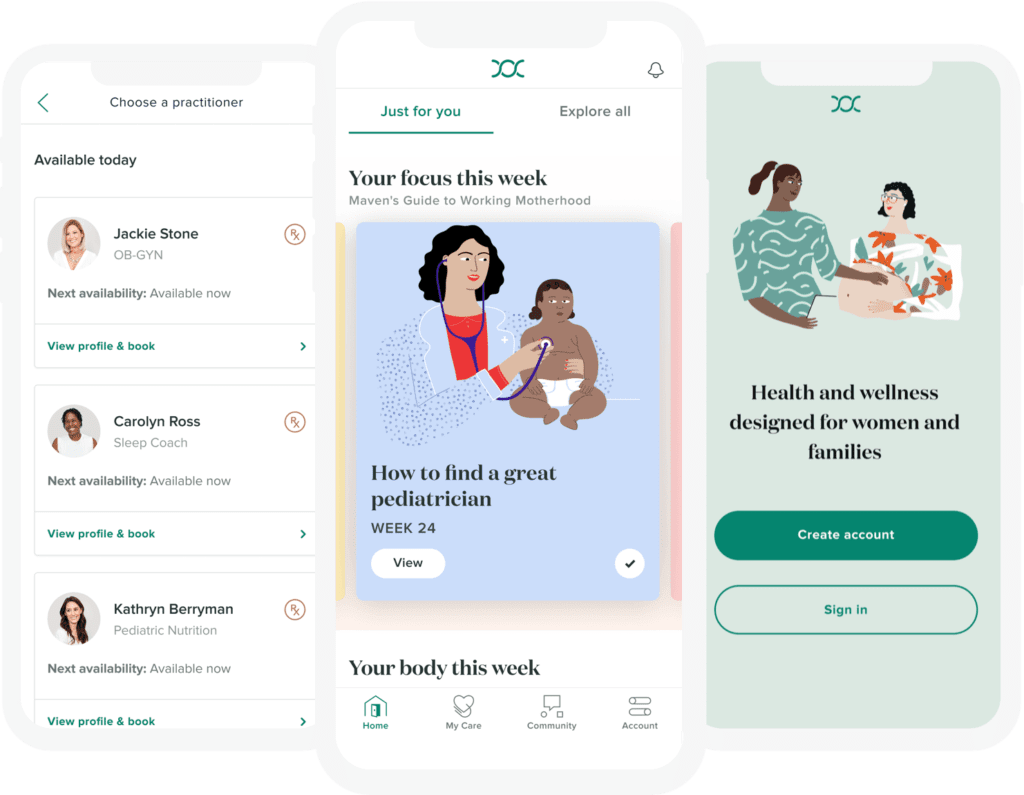 The ability to visualize customers as they go about their daily activities and answer questions like these is key to delivering a flawless user experience.
The ability to visualize customers as they go about their daily activities and answer questions like these is key to delivering a flawless user experience.
In addition, automated tests during the development step performed by developers will help catch most pesky bugs.
I also recommend integrating a QA service like Crashlytics or Sentry that automates bug discovery and makes it simpler to identify issues and fix them while you build a period tracker mobile app.
Related: Quality Assurance Guide: Steps, Tools, Best Practices
Step #5: Release and maintain
Let’s say you’ve created a period tracker application and thoroughly tested it. What’s next? Right, you need to submit it to the App Store and Google Play.
Going public
A word of advice here is to allocate at least a week for the app submission process, even though Apple claims to process new apps within 24 to 48 hours. The thing is, Apple may reject your application, and it’s best if you still have time to fix it.
What are some common reasons for rejecting a health app in the App Store?
- failure to use secure protocols (or Apple’s App Transport Security)
- push notifications contain PHI or feature promotions
- personal health information is stored in iCloud
- lack of a privacy policy and consent form
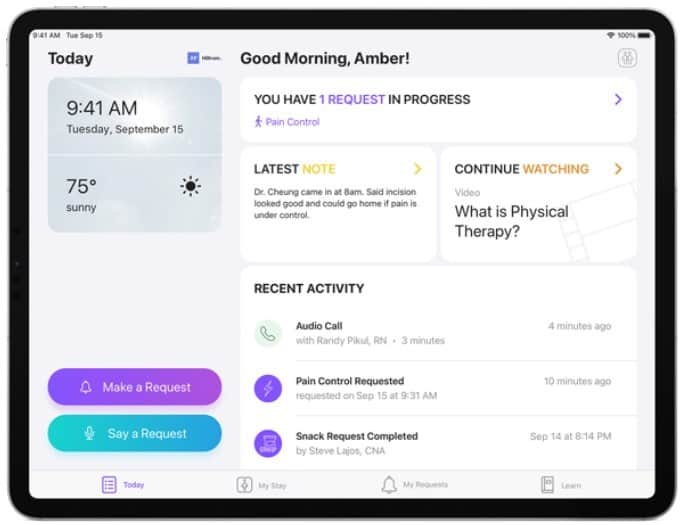 It’s possible that you will run into some other challenges, mainly if you use ResearchKit without explaining to users how their data will be used or if your app is meant for diagnosing. The same goes for Google Play, which also imposes certain restrictions on health applications admitted to the store.
It’s possible that you will run into some other challenges, mainly if you use ResearchKit without explaining to users how their data will be used or if your app is meant for diagnosing. The same goes for Google Play, which also imposes certain restrictions on health applications admitted to the store.
In short, the app store submission process can be pretty intimidating, and you should seek assistance from a qualified health app development team.
Maintenance
After the app has become available for download in the app stores, it’s time to celebrate. And to keep monitoring its performance using the tools you integrated with, for example, Google Analytics or Mixpanel, and Crashlytics.
Besides gauging user engagement and catching rare bugs, you will need to update the app as new mobile OS versions become available and bring more exciting features for users.
Best Practices and Challenges of Starting a Women’s Health Tracking App
Let’s review the best practices at your disposal when you make a period tracker mobile application or some other femtech app.
- Smooth onboarding
Show your customers what they can do with the app without immediately asking for a sign-up.
In an ideal world, women can use the app without signing up. If they want to access specific features, e.g., enter health information, they need to sign up.
![]()
Use Sign in with Apple, Google, or Facebook ID to provide a seamless onboarding experience.
- Granular notifications
Let’s admit it, nobody likes the distraction of too many notifications. At the same time, you may need to update users on different actions they need to take or certain phases in their cycle. Place granular notification controls right inside an iPhone app so customers can choose which notifications they agree to receive.
Otherwise, they can turn off all notifications in one fell swoop from the general settings. Note that you can have granular notifications in Android right in the OS settings menu.
- Interestingly, not all women favor flashy pink designs for healthcare apps
I’ve come across comments where women were very skeptical about pinky designs of lady-time tracking apps. That’s because the rose colors immediately give away what kind of app is being used, and that’s not very comfortable when running an app in public.
So consider a more discreet color palette, maybe. I’d also recommend creating widgets that can sit on the Home screen and let women quickly check on their health without providing too many visual clues to bystanders.
- Women love to chat
Many apps add chats to their feature set, trying to create a better sense of community around their solutions. Group chats or moderated forums are for sharing advice. Still, you can also start with a chatbot that provides general assistance.
Related: How to Build a Healthcare Chatbot
- Integrate with medical facilities
Use CareKit to let women easily share their health data with care providers right through the app.
- Smartwatch app
Offering the tidbits of women’s wellness info on a wrist can be a compelling option, especially when a watch app comes as part and parcel of a subscription service.
Related: Develop a wearable app for Android and iOS
![]()
- Healthcare domain expertise
Last but not least is having certified providers contributing to your women’s health app features. The best femtech applications have the solid backing of established healthcare experts.
How Can Topflight Apps Expertise Help You Develop Apps for Women’s Health?
At Topflight Apps, we’re lucky to work with forward-thinking women entrepreneurs envisioning innovative femtech products. Some recent projects that come to mind include a treatment planning app for a medspa and a teledermatology app for skincare.
Please schedule a free call if you need more details on how to create a women’s health tracker app from scratch.
Related Articles:
- HIPAA Compliant App Development
- Guide to Building a Doctor’s Appointment App
- Mental Health App Development
- How to develop an EHR/EMR system
- How to develop a hospital management system
- Telehealth App Development Guide
- A Complete Guide to Chatbots in Healthcare
- Healthcare App Development Guide
- How to Integrate a Health App with Epic EHR/EMR
[This blog was originally published on 8/21/2021, but has been updated with more recent data]
Frequently Asked Questions
What is femtech?
Femtech is short for female technology — tech that supports women’s health.
Can male designers create appealing user interfaces for women's health apps?
Apparently yes, although we’d instead rely on female designers for some projects during the period tracking app development.
What are the main trends behind the most popular women's health apps?
It’s a combination of IoT, AI, and telemedicine.
Do I need to use some particular technologies for menstruation tracking app development?
To start a period tracker app, you’re absolutely free to use whatever tech stack fitting your business use cases: either native development, using Swift/Kotlin, or cross-platform tools.
I want to develop a machine learning application for iOS only. What will be my biggest challenge?
Compressing the ML model to a manageable size, especially if you envision on-device ML usage.


